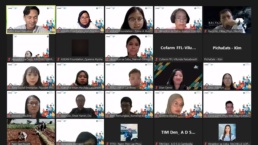The second online training of ASEAN SEDP 2.0 delved deeper into impact measurement. The second session, held on 6 Sep 2023, was led by Dian Onno, Founder and Director of DKK Consulting, and Pauline Tan, Principal of Soristic. At the beginning of the session, Dian discussed Impact Measurement Fundamentals.
Dian quoted the ASHOKA definition of a social enterprise, which states that social entrepreneurs are individuals with innovative solutions to society’s most pressing social, cultural, and environmental challenges. They are ambitious and persistent, tackling major issues and offering new ideas for systems-level change.
“In the short term, social enterprises will be balancing impact and profit, so social entrepreneurs will need to have an impact model and a business model,” said Dian.
Dian added that some characteristics of a social enterprise include the need to create social impact, have a viable business model to continue making a social impact, integrate the impact mission into business processes, and have defined and measurable indicators. She also inquired about the indicators of success for a social enterprise.
In response to this, Prisa Senduangdeth, CMTO & COO of Cofarm – Farm for Local expressed that their definition of success is increasing income for local farmers and reducing costs for restaurants, both of which are beneficiaries of Cofarm. Cofarm is a social enterprise in Laos that revolutionised agriculture through sustainable and data-driven hydroponics farming practices. Their mission is to empower farmers and restaurants, promote food security, and contribute to environmental sustainability.
Impact measurement is crucial for a social enterprise, both for internal and external reasons. These internal reasons often serve as motivation for social entrepreneurs to persevere. Internally, impact measurement serves several purposes. First, it enhances decision-making by helping determine what actions to take and what to avoid. Second, it inspires and motivates the team by clearly articulating the positive change they are contributing to. Third, it fosters a commitment to continuous improvement and making a meaningful social impact.
On the other hand, there are external reasons for impact measurement. First, it helps in engaging with the existing market and acquiring new conscious consumers who are interested in supporting socially responsible businesses. Second, it attracts investors by demonstrating that the organisation is effective and impactful, making it a more appealing investment opportunity. Third, it strengthens the organisation’s impactful reputation by taking an evidence-based and transparent approach to its social mission.
Dian then explained that there are many methods for measuring impact, ranging from impact models to IRIS+, SROI (Social Return on Investment), and Certified B Corporation. However, Dian tends to focus on and recommends the use of an impact model due to its simplicity, widespread acceptance, ease of development, and its role as an excellent starting point for impact measurement.
This impact model is used to plan how the organisation will achieve the outputs and outcomes, measure and evaluate progress toward achieving impact goals, and communicate their theory of change to stakeholders,” explained Dian.
Jorelyn Concepcion, the director of Hinablon Sa Cebu, inquired further whether impact assessment could be conducted independently by social enterprises. Hinablon Sa Cebu is a thriving social enterprise that emerged from a community extension project initiated by Cebu Technological University (CTU). Founded with the aim of revitalising the handloom weaving industry in Argao, Cebu, Philippines, Hinablon Sa Cebu collaborates with private and government sectors to provide sustainable livelihood opportunities for marginalised communities.
In response to this, Dian explained that at the early stage of a social enterprise, it can be done by the social enterprise itself. Social entrepreneurs can also collect data (customer and product data). However, ideally, to prevent bias perspectives, a third party can be used to conduct the impact measurement.
Pauline Tan then elaborated on data collection and analysis. According to her, there are various tools that can be used for data collection, ranging from Google Forms, Survey Monkey, Kobo Toolbox, and Qualtrics. Each of them has diverse features, and there are both free and paid options available for use by social entrepreneurs.
Regarding data analysis, there are several types of analyses that can be performed. First, descriptive analysis is used to understand what is happening, such as examining sales data to identify an increase in sales of a particular product in the last quarter of this year. Second, diagnostic analysis is used to answer the question, “Why did this happen?” For instance, it involves comparing trends, uncovering correlations, and determining causal relationships. An example is analysing customer data to find out that the surge in sales was due to adults buying products as gifts for the holiday season.
Then, predictive analysis is used to answer the question, “What might happen in the future?” For example, it helps make informed predictions about what will occur next year. It’s likely that we will see the same surge in sales during the next year’s last quarter. The last type is prescriptive analysis, which answers the question, “What should we do about it?” It takes into account all possible factors in a scenario and suggests actionable takeaways. Data analysis is used to make informed decisions.
Towards the end of the session, Pauline discussed the challenges often faced by organisations in integrating impact measurement into their organisational culture. She emphasised the need for a commitment and shared belief in the value of impact measurement by all parties, including funders, investors, management, and operational staff. This commitment involves allocating resources such as time, manpower, and budget for implementation, and operational staff committing to data collection and analysis.


